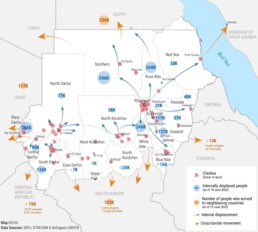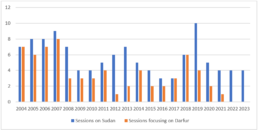On why Darfur deserves a special attention
Date | 22 June 2023
Solomon Ayele Dersso, PhD
Founding Director, Amani Africa
Tsion Hagos
Senior Researcher, Amani Africa
Zekarias Beshah Abebe
Senior Researcher, Amani Africa
Since the outbreak of fighting in Sudan on 15 April 2023, the part of the country that has come to experience the most violence is Darfur. Outside Khartoum, Darfur is the one region where the fighting affected most parts of the region. It is in Darfur that the fighting has taken worrying levels of intercommunal dimension. It is also here that the fighting not only endangers to tear apart the already fragile and violence ridden relations between various communities, but also to result in mass atrocities. This is accordingly a situation that warrants special attention of the African Union (AU) Peace and Security Council (PSC).
It is in Darfur that the fighting has taken worrying levels of intercommunal dimension. It is also here that the fighting not only endangers to tear apart the already fragile and violence ridden relations between various communities, but also to result in mass atrocities.
Although the signing of local peace agreements led by local leaders and committees initially sought to minimize the degeneration of the fighting between the Sudanese Armed Force (SAF) and the Rapid Support Force (RSF) into widespread inter-communal violence, it was unable to forestall it.
El Geneina, capital of West Darfur and a city close to the border with Chad, is perhaps the most affected by the violence. It reportedly witnessed the killing of significant number of people, widespread damage and destruction of both public and private property and lootings. According to OCHA’s Humanitarian update for 22 June, ‘[t]here are also reports of ethnically-motivated targeted killings, sexual violence, widespread burning of homes and mass displacement of non-Arab residents–particularly in and around the city of Ag Geneina (sic)–by the RSF and allied Arab militias.’
According to various reports, the violence in West Darfur taking the form of ethnic cleansing turns out to be one of, if not the, deadliest thus far and most atrocious. According to Sudan’s Doctors Union, the conflict in El Geneina has led to the death of over 1000 people. It has also forced tens of thousands into internal displacement or into crossing to Chad to seek refuge.

It is the fact that the outbreak of fighting between the RSF and SAF has come to intersect with existing conflict dynamics that makes the situation in Darfur particular and deserving of its own special attention. Despite some improvement in the overall conflict situation, Darfur did not recover peace fully. Not only that the conditions that led to the outbreak of war in 2003 have not been fully resolved but the war and most importantly the atrocities committed along ethnic lines targeting in particular non-Arab communities also created new grievances.
It is the fact that the outbreak of fighting between the RSF and SAF has come to intersect with existing conflict dynamics that makes the situation in Darfur particular and deserving of its own special attention.
In recent years and particularly since the ouster of Bashir and with new recruitment drives and the deepening of ties between the RSF and Arab militias, these conflict issues have become more acute and induced recurring incidents of violence. This is most notable in Western Darfur. According to the 2022 report of the UN Sanctions Committee, ‘[t]he city of El Geneina and neighboring areas of West Darfur have experienced regular and significant outbreaks of violence since 2019. In April 2021, the upsurge of violence had reached catastrophic dimension.’ It went on to report that ‘[l]ocal sources argued that the events took the form of ethnic cleansing, directed against the Masalit and other non-Arab communities.’
The fighting between the RSF and the SAF therefore seems to affect Darfur in two ways. First, it has adda a new axis of conflict in Darfur between entities that previously fought against Darfur armed groups jointly. Perhaps, most importantly, this fighting has made the resurgent conflict dynamics in Darfur much more violent and destructive. Media reports indicate that the attacks in El Geneina are largely by Arab militias and the RSF and they mainly targeted non-Arab groups, particularly the Masalit.
On 14 June, West Darfur’s Governor, Khamis Abdullah Abbaker, was killed in El Geneina shortly after he implicated the RSF for the atrocities being committed in the town. Reports attributed the killing to Arab militias and the RSF, although the paramilitary group denied the assertions. Following this killing, the OCHA update reported that ‘at least 15,000 people, including Sudanese refugees and 3,000 Chadian returnees have reportedly crossed into Chad.’
Other parts of Darfur are also experiencing increasing levels of violence. It is reported that the RSF has stepped up attacks elsewhere in Darfur in attempt to ascertain its dominance in Darfur. The outbreak of clashes in North Darfur, in Tawila town on 16 June, led to killing and injury of civilians, including internally displaced people and widespread displacement.

While much of the diplomatic attention is focused on the fighting between SAF and RSF generally, this should not lead to overlooking the specificities of the conflict dynamics in Darfur that warrant its own attention and intervention.
The nature and the scale of the violence as well as its impact on civilians of the targeted communities raises risks of a repeat of the genocidal violence of the previous Darfur war. What makes the situation particularly dangerous is that those being attacked are not receiving any protection from the SAF, which reportedly withdrew from El Geneina. On 13 June, the Special Representative of the Secretary-General for Sudan and Head of the United Nations Integrated Transition Assistance Mission in Sudan (UNITAMS), Volker Perthes, released a statement warning that the violence in El Geneina could amount to crimes against humanity. He indicated an ‘emerging pattern of large-scale targeted attacks against civilians based on their ethnic identities, allegedly committed by Arab militias and some armed men in Rapid Support Force (RSF)’s uniform.’
The PSC has both a legal and historical responsibility. The situation in Sudan, involving the war in Darfur and the north-South conflict, has attracted the most attention from the PSC. Since 2004, the PSC dedicated the largest number of sessions to Sudan pursuant to Amani Africa’s database.

Nearly 2/3 of PSC sessions on Sudan were tied to Darfur. Darfur was the first of conflict situations that featured on the agenda of the PSC when the PSC became operational in March 2004. It is also here with respect to the conflict in Darfur that PSC deployed various conflict management and resolution tools.
The first peace support operation that the PSC deployed was the AU Mission to Sudan (AMIS) that provided the first international presence in Darfur, contributing to reduction of violence against civilians. It is also here that the PSC for the first time established a high-level panel, the AU High-Level Panel on Darfur (AUPD) which later became AU High-level Panel on Sudan (AUHIP), setting an example for the high-level panel as a model of AU’s diplomatic action for mediation and peacemaking.
The nature of the violence in Darfur involving mass atrocities including those that may amount to crimes against humanity and ethnic cleansing legally implicate PSC’s action. Additionally, the role the PSC played with respect to the Darfur war also places historical responsibility for it to pay special attention to Darfur. Urgent action by the PSC can contribute towards averting the situation in Darfur from spiraling completely out of control. This the PSC can accomplish at the very least through convening a dedicated session for mobilizing diplomatic and humanitarian attention and action the situation in Darfur demands.
The content of this article does not represent the views of Amani Africa and reflect only the personal views of the authors who contribute to ‘Ideas Indaba’